Enterprise Risk Management in Australian Private Procurement Contracts
VerifiedAdded on 2023/01/19
|49
|20756
|55
Thesis and Dissertation
AI Summary
This thesis investigates enterprise risk management (ERM), self-organization, networking, and their impact on financial performance within Australian private procurement contracts. The research explores the critical issues businesses face in procurement, including quality, price, and supply chain management. It examines the role of ERM in mitigating risks, improving stakeholder communication, and enhancing financial outcomes. The study delves into the relationship between ERM, self-organization, and networking, highlighting how these factors influence risk resilience and financial stability. The research questions address the impact of ERM on financial performance, the connection between ERM and self-organization, and the role of networking in risk management. The thesis also provides an overview of the research methodology, including data collection, analysis, and ethical considerations. Furthermore, the research analyzes various types of risk, such as credit risk, market risk, liquidity risk, and operational risk, and their effects on financial outcomes. The study also investigates the importance of supplier management and the significance of integrating risk management strategies within procurement processes. This research aims to enhance the understanding of risk management practices and their effects on the financial success of private procurement firms in Australia.
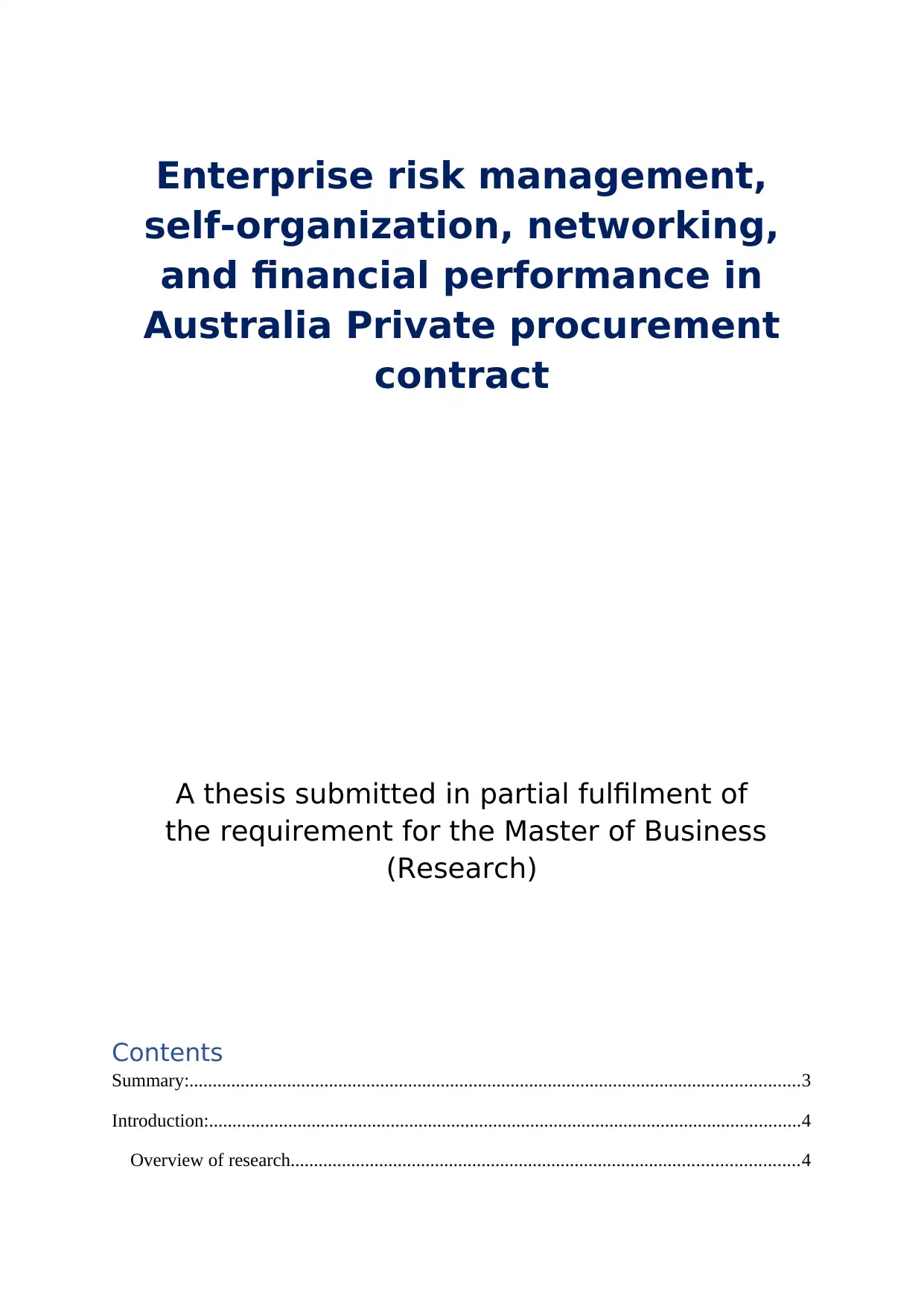
Enterprise risk management,
self-organization, networking,
and financial performance in
Australia Private procurement
contract
A thesis submitted in partial fulfilment of
the requirement for the Master of Business
(Research)
Contents
Summary:...................................................................................................................................3
Introduction:...............................................................................................................................4
Overview of research.............................................................................................................4
self-organization, networking,
and financial performance in
Australia Private procurement
contract
A thesis submitted in partial fulfilment of
the requirement for the Master of Business
(Research)
Contents
Summary:...................................................................................................................................3
Introduction:...............................................................................................................................4
Overview of research.............................................................................................................4
Paraphrase This Document
Need a fresh take? Get an instant paraphrase of this document with our AI Paraphraser
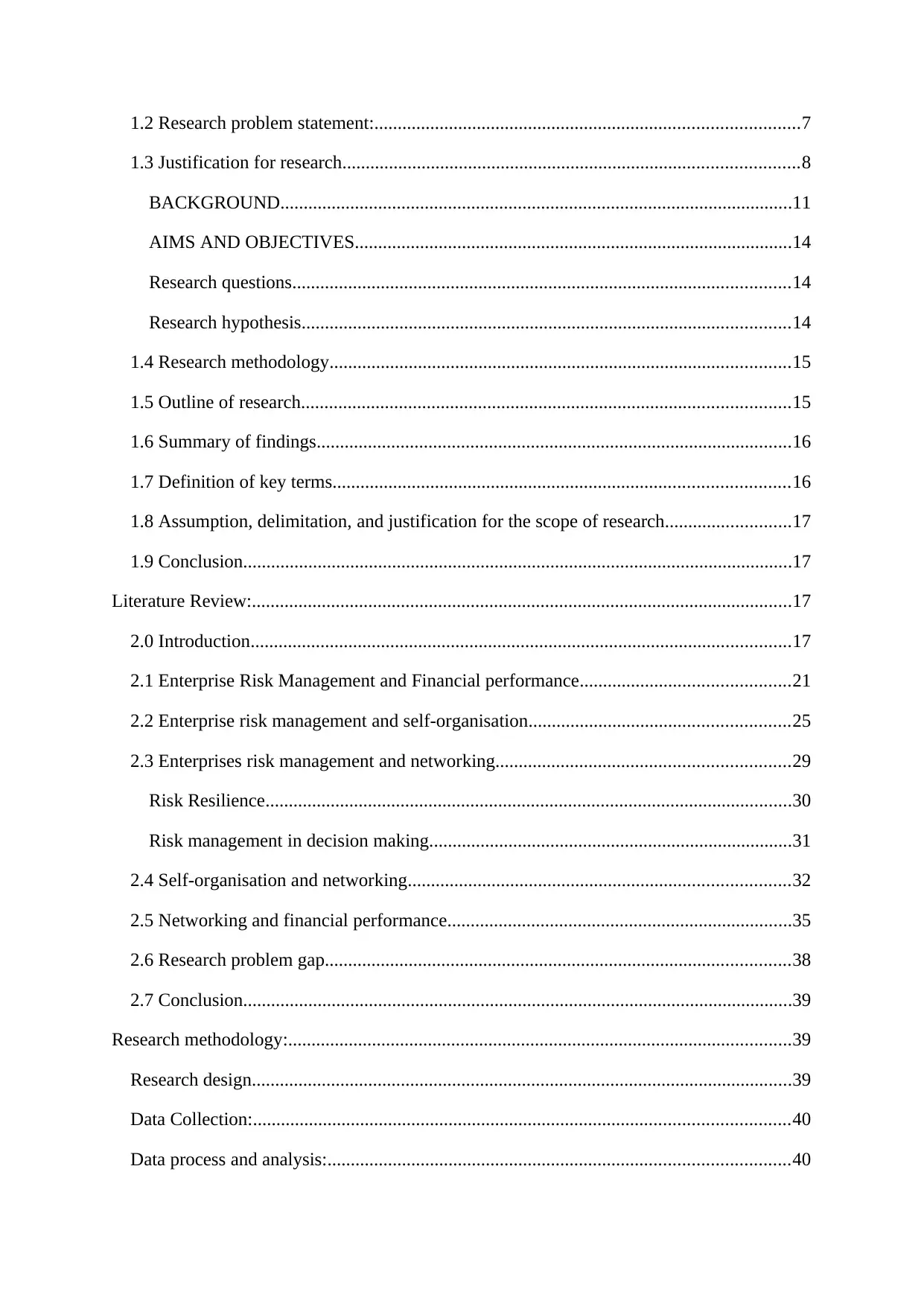
1.2 Research problem statement:...........................................................................................7
1.3 Justification for research..................................................................................................8
BACKGROUND..............................................................................................................11
AIMS AND OBJECTIVES..............................................................................................14
Research questions...........................................................................................................14
Research hypothesis.........................................................................................................14
1.4 Research methodology...................................................................................................15
1.5 Outline of research.........................................................................................................15
1.6 Summary of findings......................................................................................................16
1.7 Definition of key terms..................................................................................................16
1.8 Assumption, delimitation, and justification for the scope of research...........................17
1.9 Conclusion......................................................................................................................17
Literature Review:....................................................................................................................17
2.0 Introduction....................................................................................................................17
2.1 Enterprise Risk Management and Financial performance.............................................21
2.2 Enterprise risk management and self-organisation........................................................25
2.3 Enterprises risk management and networking...............................................................29
Risk Resilience.................................................................................................................30
Risk management in decision making..............................................................................31
2.4 Self-organisation and networking..................................................................................32
2.5 Networking and financial performance..........................................................................35
2.6 Research problem gap....................................................................................................38
2.7 Conclusion......................................................................................................................39
Research methodology:............................................................................................................39
Research design....................................................................................................................39
Data Collection:...................................................................................................................40
Data process and analysis:...................................................................................................40
1.3 Justification for research..................................................................................................8
BACKGROUND..............................................................................................................11
AIMS AND OBJECTIVES..............................................................................................14
Research questions...........................................................................................................14
Research hypothesis.........................................................................................................14
1.4 Research methodology...................................................................................................15
1.5 Outline of research.........................................................................................................15
1.6 Summary of findings......................................................................................................16
1.7 Definition of key terms..................................................................................................16
1.8 Assumption, delimitation, and justification for the scope of research...........................17
1.9 Conclusion......................................................................................................................17
Literature Review:....................................................................................................................17
2.0 Introduction....................................................................................................................17
2.1 Enterprise Risk Management and Financial performance.............................................21
2.2 Enterprise risk management and self-organisation........................................................25
2.3 Enterprises risk management and networking...............................................................29
Risk Resilience.................................................................................................................30
Risk management in decision making..............................................................................31
2.4 Self-organisation and networking..................................................................................32
2.5 Networking and financial performance..........................................................................35
2.6 Research problem gap....................................................................................................38
2.7 Conclusion......................................................................................................................39
Research methodology:............................................................................................................39
Research design....................................................................................................................39
Data Collection:...................................................................................................................40
Data process and analysis:...................................................................................................40
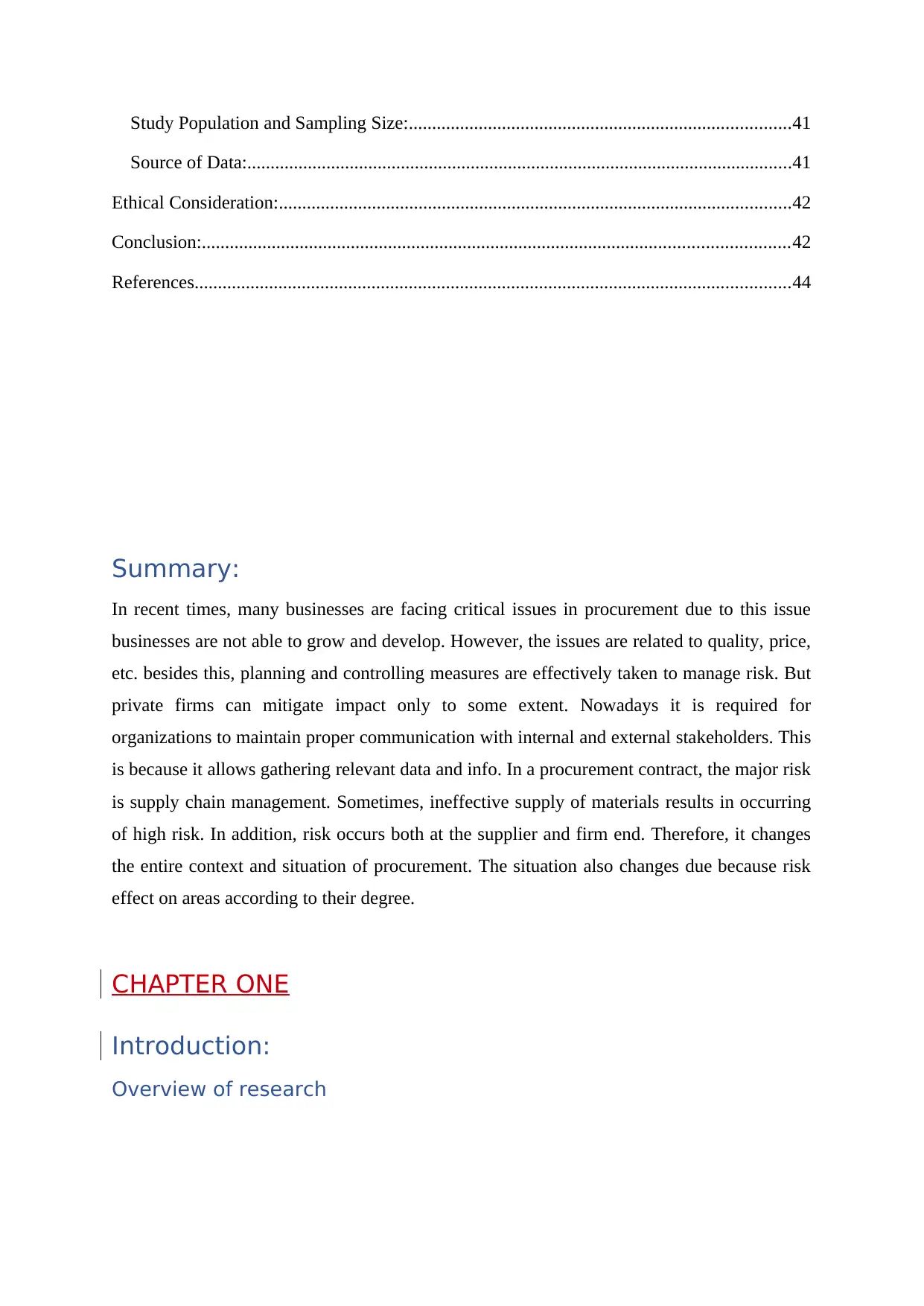
Study Population and Sampling Size:..................................................................................41
Source of Data:.....................................................................................................................41
Ethical Consideration:..............................................................................................................42
Conclusion:..............................................................................................................................42
References................................................................................................................................44
Summary:
In recent times, many businesses are facing critical issues in procurement due to this issue
businesses are not able to grow and develop. However, the issues are related to quality, price,
etc. besides this, planning and controlling measures are effectively taken to manage risk. But
private firms can mitigate impact only to some extent. Nowadays it is required for
organizations to maintain proper communication with internal and external stakeholders. This
is because it allows gathering relevant data and info. In a procurement contract, the major risk
is supply chain management. Sometimes, ineffective supply of materials results in occurring
of high risk. In addition, risk occurs both at the supplier and firm end. Therefore, it changes
the entire context and situation of procurement. The situation also changes due because risk
effect on areas according to their degree.
CHAPTER ONE
Introduction:
Overview of research
Source of Data:.....................................................................................................................41
Ethical Consideration:..............................................................................................................42
Conclusion:..............................................................................................................................42
References................................................................................................................................44
Summary:
In recent times, many businesses are facing critical issues in procurement due to this issue
businesses are not able to grow and develop. However, the issues are related to quality, price,
etc. besides this, planning and controlling measures are effectively taken to manage risk. But
private firms can mitigate impact only to some extent. Nowadays it is required for
organizations to maintain proper communication with internal and external stakeholders. This
is because it allows gathering relevant data and info. In a procurement contract, the major risk
is supply chain management. Sometimes, ineffective supply of materials results in occurring
of high risk. In addition, risk occurs both at the supplier and firm end. Therefore, it changes
the entire context and situation of procurement. The situation also changes due because risk
effect on areas according to their degree.
CHAPTER ONE
Introduction:
Overview of research
⊘ This is a preview!⊘
Do you want full access?
Subscribe today to unlock all pages.

Trusted by 1+ million students worldwide
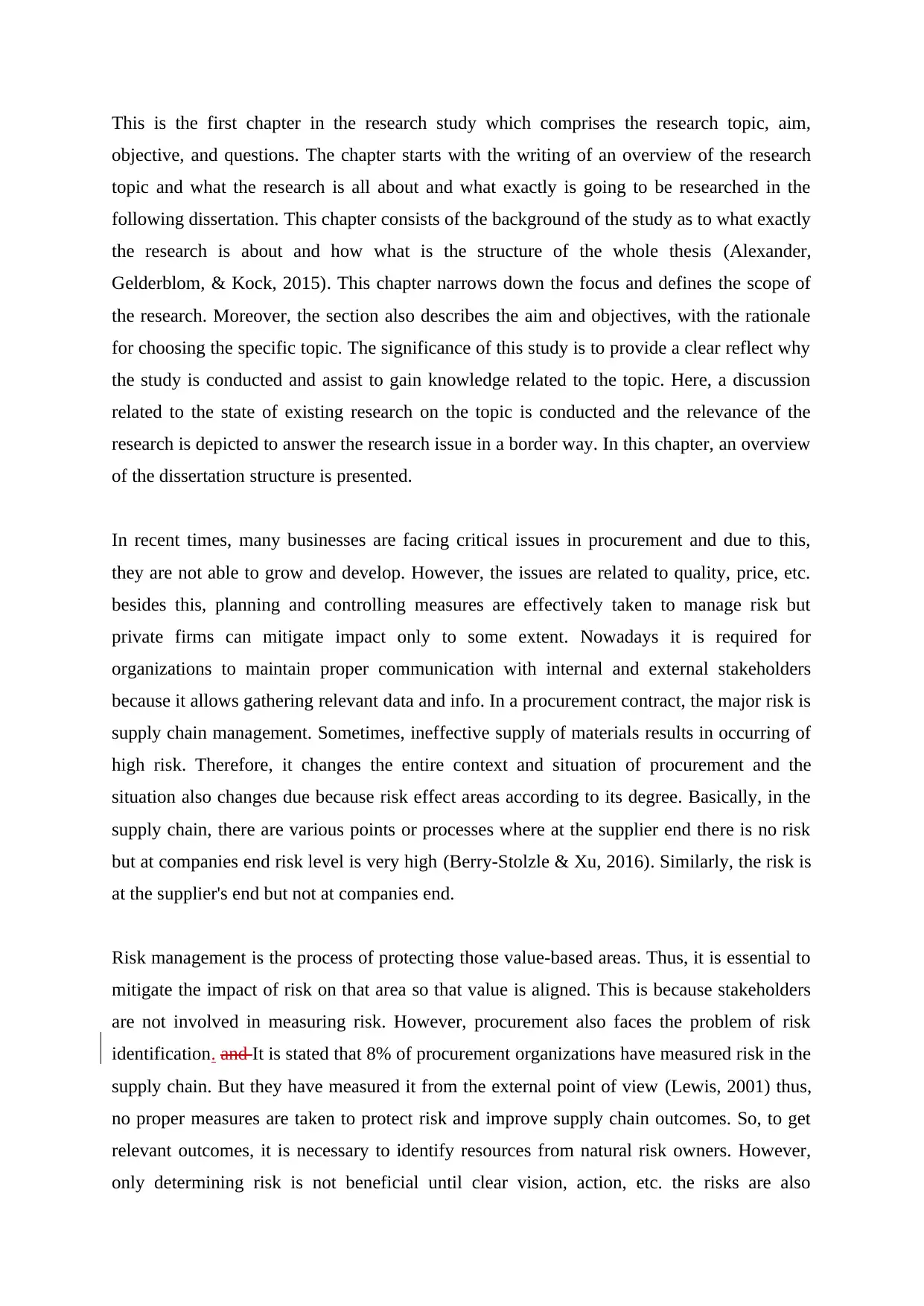
This is the first chapter in the research study which comprises the research topic, aim,
objective, and questions. The chapter starts with the writing of an overview of the research
topic and what the research is all about and what exactly is going to be researched in the
following dissertation. This chapter consists of the background of the study as to what exactly
the research is about and how what is the structure of the whole thesis (Alexander,
Gelderblom, & Kock, 2015). This chapter narrows down the focus and defines the scope of
the research. Moreover, the section also describes the aim and objectives, with the rationale
for choosing the specific topic. The significance of this study is to provide a clear reflect why
the study is conducted and assist to gain knowledge related to the topic. Here, a discussion
related to the state of existing research on the topic is conducted and the relevance of the
research is depicted to answer the research issue in a border way. In this chapter, an overview
of the dissertation structure is presented.
In recent times, many businesses are facing critical issues in procurement and due to this,
they are not able to grow and develop. However, the issues are related to quality, price, etc.
besides this, planning and controlling measures are effectively taken to manage risk but
private firms can mitigate impact only to some extent. Nowadays it is required for
organizations to maintain proper communication with internal and external stakeholders
because it allows gathering relevant data and info. In a procurement contract, the major risk is
supply chain management. Sometimes, ineffective supply of materials results in occurring of
high risk. Therefore, it changes the entire context and situation of procurement and the
situation also changes due because risk effect areas according to its degree. Basically, in the
supply chain, there are various points or processes where at the supplier end there is no risk
but at companies end risk level is very high (Berry-Stolzle & Xu, 2016). Similarly, the risk is
at the supplier's end but not at companies end.
Risk management is the process of protecting those value-based areas. Thus, it is essential to
mitigate the impact of risk on that area so that value is aligned. This is because stakeholders
are not involved in measuring risk. However, procurement also faces the problem of risk
identification. and It is stated that 8% of procurement organizations have measured risk in the
supply chain. But they have measured it from the external point of view (Lewis, 2001) thus,
no proper measures are taken to protect risk and improve supply chain outcomes. So, to get
relevant outcomes, it is necessary to identify resources from natural risk owners. However,
only determining risk is not beneficial until clear vision, action, etc. the risks are also
objective, and questions. The chapter starts with the writing of an overview of the research
topic and what the research is all about and what exactly is going to be researched in the
following dissertation. This chapter consists of the background of the study as to what exactly
the research is about and how what is the structure of the whole thesis (Alexander,
Gelderblom, & Kock, 2015). This chapter narrows down the focus and defines the scope of
the research. Moreover, the section also describes the aim and objectives, with the rationale
for choosing the specific topic. The significance of this study is to provide a clear reflect why
the study is conducted and assist to gain knowledge related to the topic. Here, a discussion
related to the state of existing research on the topic is conducted and the relevance of the
research is depicted to answer the research issue in a border way. In this chapter, an overview
of the dissertation structure is presented.
In recent times, many businesses are facing critical issues in procurement and due to this,
they are not able to grow and develop. However, the issues are related to quality, price, etc.
besides this, planning and controlling measures are effectively taken to manage risk but
private firms can mitigate impact only to some extent. Nowadays it is required for
organizations to maintain proper communication with internal and external stakeholders
because it allows gathering relevant data and info. In a procurement contract, the major risk is
supply chain management. Sometimes, ineffective supply of materials results in occurring of
high risk. Therefore, it changes the entire context and situation of procurement and the
situation also changes due because risk effect areas according to its degree. Basically, in the
supply chain, there are various points or processes where at the supplier end there is no risk
but at companies end risk level is very high (Berry-Stolzle & Xu, 2016). Similarly, the risk is
at the supplier's end but not at companies end.
Risk management is the process of protecting those value-based areas. Thus, it is essential to
mitigate the impact of risk on that area so that value is aligned. This is because stakeholders
are not involved in measuring risk. However, procurement also faces the problem of risk
identification. and It is stated that 8% of procurement organizations have measured risk in the
supply chain. But they have measured it from the external point of view (Lewis, 2001) thus,
no proper measures are taken to protect risk and improve supply chain outcomes. So, to get
relevant outcomes, it is necessary to identify resources from natural risk owners. However,
only determining risk is not beneficial until clear vision, action, etc. the risks are also
Paraphrase This Document
Need a fresh take? Get an instant paraphrase of this document with our AI Paraphraser
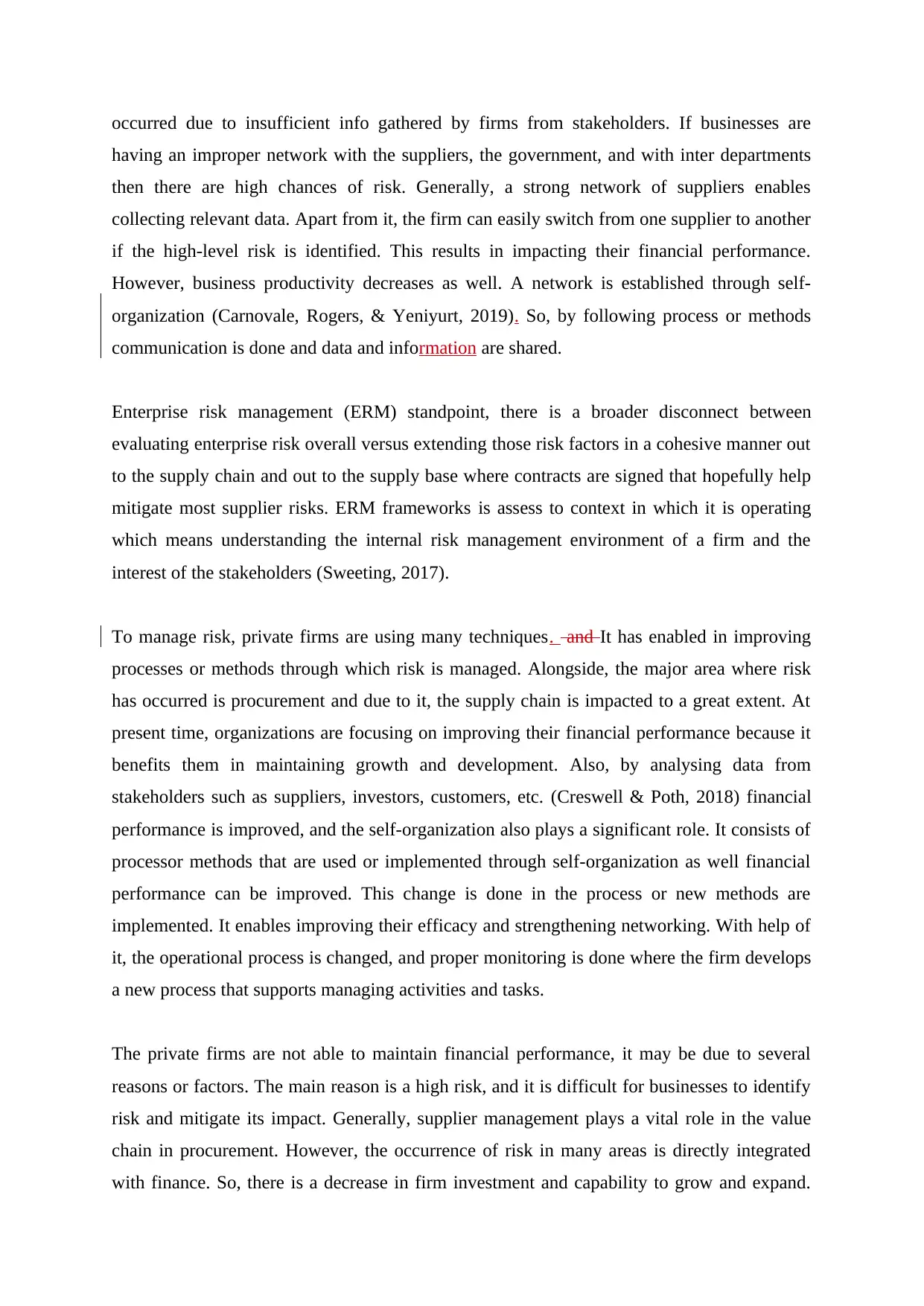
occurred due to insufficient info gathered by firms from stakeholders. If businesses are
having an improper network with the suppliers, the government, and with inter departments
then there are high chances of risk. Generally, a strong network of suppliers enables
collecting relevant data. Apart from it, the firm can easily switch from one supplier to another
if the high-level risk is identified. This results in impacting their financial performance.
However, business productivity decreases as well. A network is established through self-
organization (Carnovale, Rogers, & Yeniyurt, 2019). So, by following process or methods
communication is done and data and information are shared.
Enterprise risk management (ERM) standpoint, there is a broader disconnect between
evaluating enterprise risk overall versus extending those risk factors in a cohesive manner out
to the supply chain and out to the supply base where contracts are signed that hopefully help
mitigate most supplier risks. ERM frameworks is assess to context in which it is operating
which means understanding the internal risk management environment of a firm and the
interest of the stakeholders (Sweeting, 2017).
To manage risk, private firms are using many techniques. and It has enabled in improving
processes or methods through which risk is managed. Alongside, the major area where risk
has occurred is procurement and due to it, the supply chain is impacted to a great extent. At
present time, organizations are focusing on improving their financial performance because it
benefits them in maintaining growth and development. Also, by analysing data from
stakeholders such as suppliers, investors, customers, etc. (Creswell & Poth, 2018) financial
performance is improved, and the self-organization also plays a significant role. It consists of
processor methods that are used or implemented through self-organization as well financial
performance can be improved. This change is done in the process or new methods are
implemented. It enables improving their efficacy and strengthening networking. With help of
it, the operational process is changed, and proper monitoring is done where the firm develops
a new process that supports managing activities and tasks.
The private firms are not able to maintain financial performance, it may be due to several
reasons or factors. The main reason is a high risk, and it is difficult for businesses to identify
risk and mitigate its impact. Generally, supplier management plays a vital role in the value
chain in procurement. However, the occurrence of risk in many areas is directly integrated
with finance. So, there is a decrease in firm investment and capability to grow and expand.
having an improper network with the suppliers, the government, and with inter departments
then there are high chances of risk. Generally, a strong network of suppliers enables
collecting relevant data. Apart from it, the firm can easily switch from one supplier to another
if the high-level risk is identified. This results in impacting their financial performance.
However, business productivity decreases as well. A network is established through self-
organization (Carnovale, Rogers, & Yeniyurt, 2019). So, by following process or methods
communication is done and data and information are shared.
Enterprise risk management (ERM) standpoint, there is a broader disconnect between
evaluating enterprise risk overall versus extending those risk factors in a cohesive manner out
to the supply chain and out to the supply base where contracts are signed that hopefully help
mitigate most supplier risks. ERM frameworks is assess to context in which it is operating
which means understanding the internal risk management environment of a firm and the
interest of the stakeholders (Sweeting, 2017).
To manage risk, private firms are using many techniques. and It has enabled in improving
processes or methods through which risk is managed. Alongside, the major area where risk
has occurred is procurement and due to it, the supply chain is impacted to a great extent. At
present time, organizations are focusing on improving their financial performance because it
benefits them in maintaining growth and development. Also, by analysing data from
stakeholders such as suppliers, investors, customers, etc. (Creswell & Poth, 2018) financial
performance is improved, and the self-organization also plays a significant role. It consists of
processor methods that are used or implemented through self-organization as well financial
performance can be improved. This change is done in the process or new methods are
implemented. It enables improving their efficacy and strengthening networking. With help of
it, the operational process is changed, and proper monitoring is done where the firm develops
a new process that supports managing activities and tasks.
The private firms are not able to maintain financial performance, it may be due to several
reasons or factors. The main reason is a high risk, and it is difficult for businesses to identify
risk and mitigate its impact. Generally, supplier management plays a vital role in the value
chain in procurement. However, the occurrence of risk in many areas is directly integrated
with finance. So, there is a decrease in firm investment and capability to grow and expand.
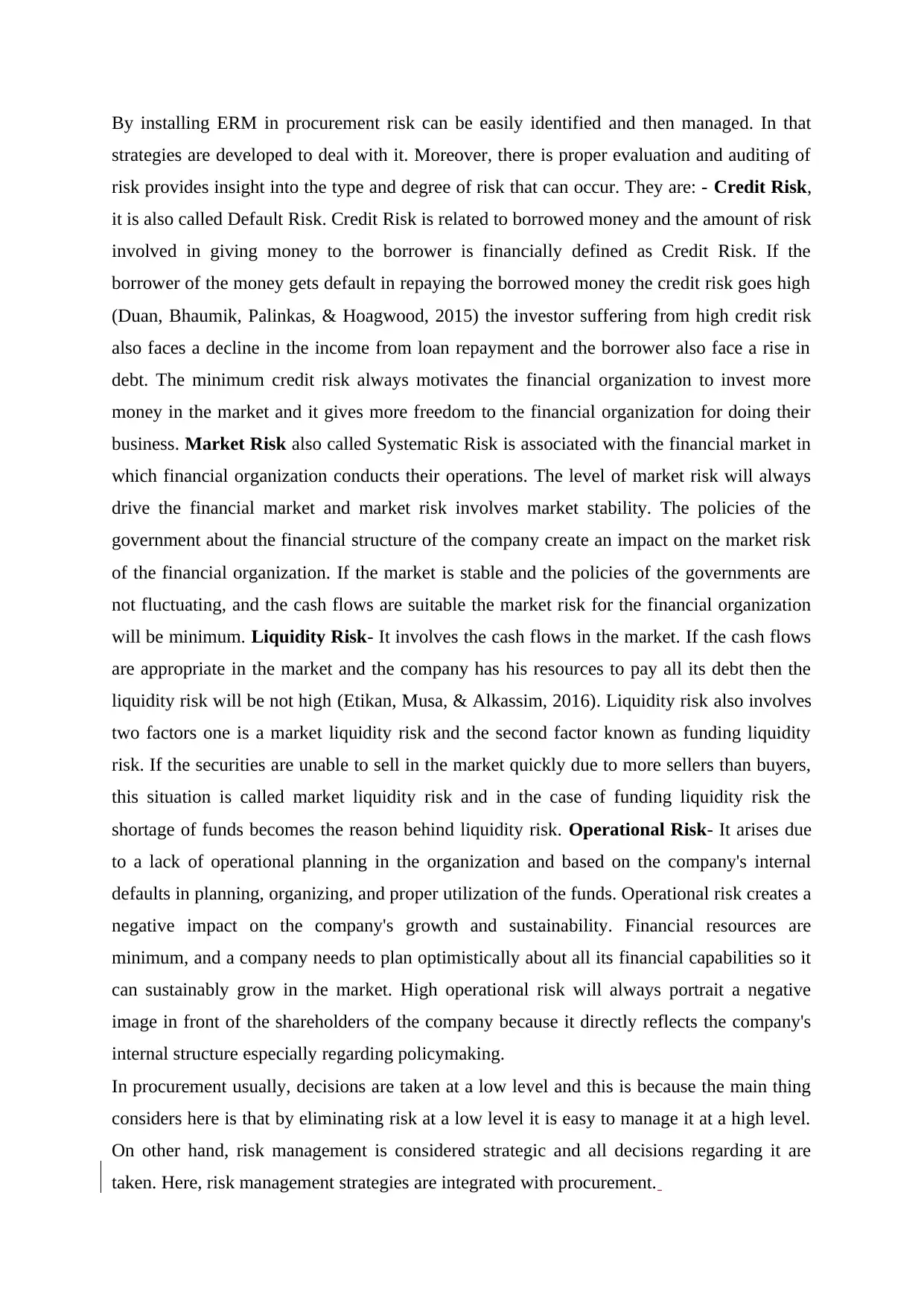
By installing ERM in procurement risk can be easily identified and then managed. In that
strategies are developed to deal with it. Moreover, there is proper evaluation and auditing of
risk provides insight into the type and degree of risk that can occur. They are: - Credit Risk,
it is also called Default Risk. Credit Risk is related to borrowed money and the amount of risk
involved in giving money to the borrower is financially defined as Credit Risk. If the
borrower of the money gets default in repaying the borrowed money the credit risk goes high
(Duan, Bhaumik, Palinkas, & Hoagwood, 2015) the investor suffering from high credit risk
also faces a decline in the income from loan repayment and the borrower also face a rise in
debt. The minimum credit risk always motivates the financial organization to invest more
money in the market and it gives more freedom to the financial organization for doing their
business. Market Risk also called Systematic Risk is associated with the financial market in
which financial organization conducts their operations. The level of market risk will always
drive the financial market and market risk involves market stability. The policies of the
government about the financial structure of the company create an impact on the market risk
of the financial organization. If the market is stable and the policies of the governments are
not fluctuating, and the cash flows are suitable the market risk for the financial organization
will be minimum. Liquidity Risk- It involves the cash flows in the market. If the cash flows
are appropriate in the market and the company has his resources to pay all its debt then the
liquidity risk will be not high (Etikan, Musa, & Alkassim, 2016). Liquidity risk also involves
two factors one is a market liquidity risk and the second factor known as funding liquidity
risk. If the securities are unable to sell in the market quickly due to more sellers than buyers,
this situation is called market liquidity risk and in the case of funding liquidity risk the
shortage of funds becomes the reason behind liquidity risk. Operational Risk- It arises due
to a lack of operational planning in the organization and based on the company's internal
defaults in planning, organizing, and proper utilization of the funds. Operational risk creates a
negative impact on the company's growth and sustainability. Financial resources are
minimum, and a company needs to plan optimistically about all its financial capabilities so it
can sustainably grow in the market. High operational risk will always portrait a negative
image in front of the shareholders of the company because it directly reflects the company's
internal structure especially regarding policymaking.
In procurement usually, decisions are taken at a low level and this is because the main thing
considers here is that by eliminating risk at a low level it is easy to manage it at a high level.
On other hand, risk management is considered strategic and all decisions regarding it are
taken. Here, risk management strategies are integrated with procurement.
strategies are developed to deal with it. Moreover, there is proper evaluation and auditing of
risk provides insight into the type and degree of risk that can occur. They are: - Credit Risk,
it is also called Default Risk. Credit Risk is related to borrowed money and the amount of risk
involved in giving money to the borrower is financially defined as Credit Risk. If the
borrower of the money gets default in repaying the borrowed money the credit risk goes high
(Duan, Bhaumik, Palinkas, & Hoagwood, 2015) the investor suffering from high credit risk
also faces a decline in the income from loan repayment and the borrower also face a rise in
debt. The minimum credit risk always motivates the financial organization to invest more
money in the market and it gives more freedom to the financial organization for doing their
business. Market Risk also called Systematic Risk is associated with the financial market in
which financial organization conducts their operations. The level of market risk will always
drive the financial market and market risk involves market stability. The policies of the
government about the financial structure of the company create an impact on the market risk
of the financial organization. If the market is stable and the policies of the governments are
not fluctuating, and the cash flows are suitable the market risk for the financial organization
will be minimum. Liquidity Risk- It involves the cash flows in the market. If the cash flows
are appropriate in the market and the company has his resources to pay all its debt then the
liquidity risk will be not high (Etikan, Musa, & Alkassim, 2016). Liquidity risk also involves
two factors one is a market liquidity risk and the second factor known as funding liquidity
risk. If the securities are unable to sell in the market quickly due to more sellers than buyers,
this situation is called market liquidity risk and in the case of funding liquidity risk the
shortage of funds becomes the reason behind liquidity risk. Operational Risk- It arises due
to a lack of operational planning in the organization and based on the company's internal
defaults in planning, organizing, and proper utilization of the funds. Operational risk creates a
negative impact on the company's growth and sustainability. Financial resources are
minimum, and a company needs to plan optimistically about all its financial capabilities so it
can sustainably grow in the market. High operational risk will always portrait a negative
image in front of the shareholders of the company because it directly reflects the company's
internal structure especially regarding policymaking.
In procurement usually, decisions are taken at a low level and this is because the main thing
considers here is that by eliminating risk at a low level it is easy to manage it at a high level.
On other hand, risk management is considered strategic and all decisions regarding it are
taken. Here, risk management strategies are integrated with procurement.
⊘ This is a preview!⊘
Do you want full access?
Subscribe today to unlock all pages.

Trusted by 1+ million students worldwide
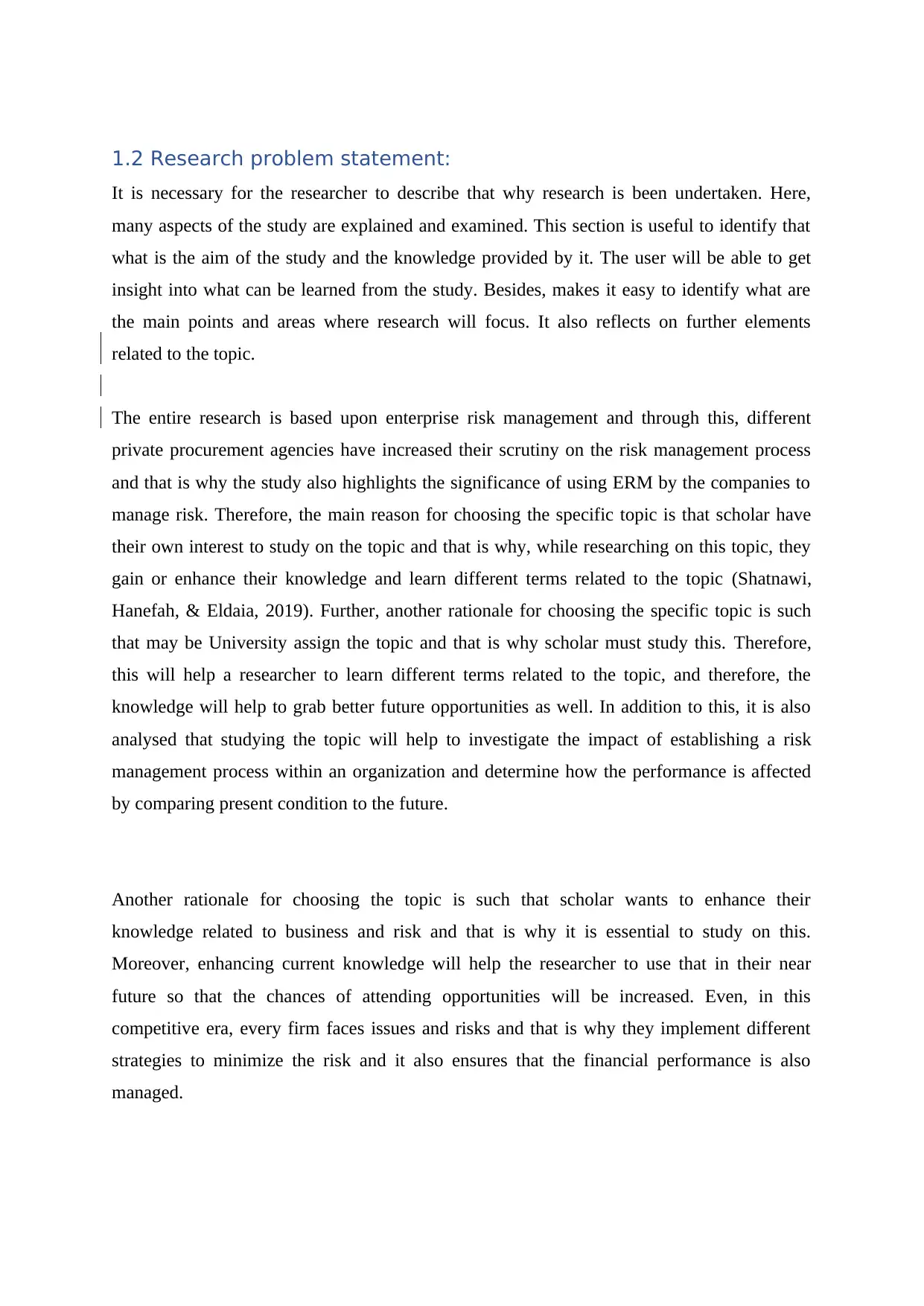
1.2 Research problem statement:
It is necessary for the researcher to describe that why research is been undertaken. Here,
many aspects of the study are explained and examined. This section is useful to identify that
what is the aim of the study and the knowledge provided by it. The user will be able to get
insight into what can be learned from the study. Besides, makes it easy to identify what are
the main points and areas where research will focus. It also reflects on further elements
related to the topic.
The entire research is based upon enterprise risk management and through this, different
private procurement agencies have increased their scrutiny on the risk management process
and that is why the study also highlights the significance of using ERM by the companies to
manage risk. Therefore, the main reason for choosing the specific topic is that scholar have
their own interest to study on the topic and that is why, while researching on this topic, they
gain or enhance their knowledge and learn different terms related to the topic (Shatnawi,
Hanefah, & Eldaia, 2019). Further, another rationale for choosing the specific topic is such
that may be University assign the topic and that is why scholar must study this. Therefore,
this will help a researcher to learn different terms related to the topic, and therefore, the
knowledge will help to grab better future opportunities as well. In addition to this, it is also
analysed that studying the topic will help to investigate the impact of establishing a risk
management process within an organization and determine how the performance is affected
by comparing present condition to the future.
Another rationale for choosing the topic is such that scholar wants to enhance their
knowledge related to business and risk and that is why it is essential to study on this.
Moreover, enhancing current knowledge will help the researcher to use that in their near
future so that the chances of attending opportunities will be increased. Even, in this
competitive era, every firm faces issues and risks and that is why they implement different
strategies to minimize the risk and it also ensures that the financial performance is also
managed.
It is necessary for the researcher to describe that why research is been undertaken. Here,
many aspects of the study are explained and examined. This section is useful to identify that
what is the aim of the study and the knowledge provided by it. The user will be able to get
insight into what can be learned from the study. Besides, makes it easy to identify what are
the main points and areas where research will focus. It also reflects on further elements
related to the topic.
The entire research is based upon enterprise risk management and through this, different
private procurement agencies have increased their scrutiny on the risk management process
and that is why the study also highlights the significance of using ERM by the companies to
manage risk. Therefore, the main reason for choosing the specific topic is that scholar have
their own interest to study on the topic and that is why, while researching on this topic, they
gain or enhance their knowledge and learn different terms related to the topic (Shatnawi,
Hanefah, & Eldaia, 2019). Further, another rationale for choosing the specific topic is such
that may be University assign the topic and that is why scholar must study this. Therefore,
this will help a researcher to learn different terms related to the topic, and therefore, the
knowledge will help to grab better future opportunities as well. In addition to this, it is also
analysed that studying the topic will help to investigate the impact of establishing a risk
management process within an organization and determine how the performance is affected
by comparing present condition to the future.
Another rationale for choosing the topic is such that scholar wants to enhance their
knowledge related to business and risk and that is why it is essential to study on this.
Moreover, enhancing current knowledge will help the researcher to use that in their near
future so that the chances of attending opportunities will be increased. Even, in this
competitive era, every firm faces issues and risks and that is why they implement different
strategies to minimize the risk and it also ensures that the financial performance is also
managed.
Paraphrase This Document
Need a fresh take? Get an instant paraphrase of this document with our AI Paraphraser
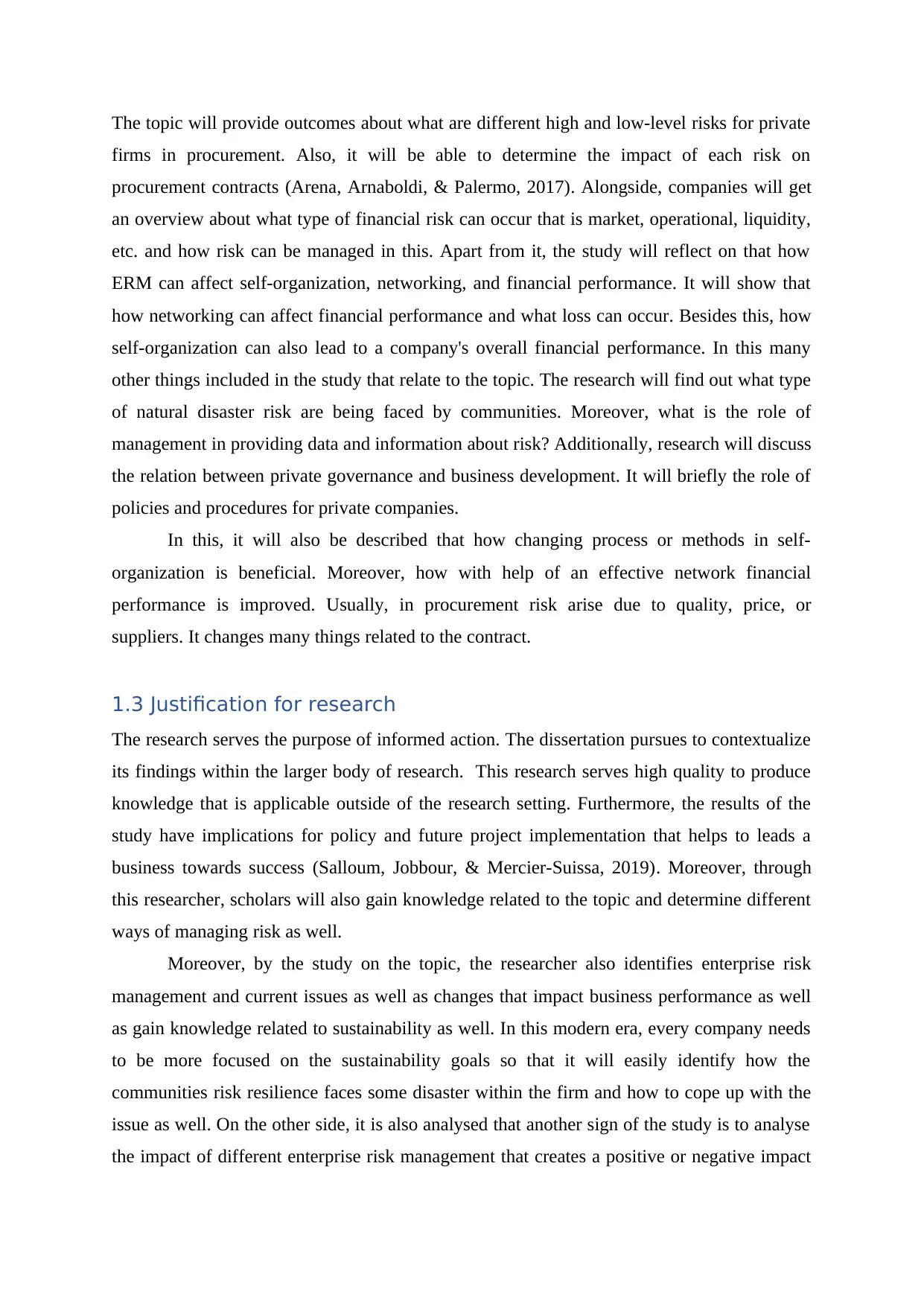
The topic will provide outcomes about what are different high and low-level risks for private
firms in procurement. Also, it will be able to determine the impact of each risk on
procurement contracts (Arena, Arnaboldi, & Palermo, 2017). Alongside, companies will get
an overview about what type of financial risk can occur that is market, operational, liquidity,
etc. and how risk can be managed in this. Apart from it, the study will reflect on that how
ERM can affect self-organization, networking, and financial performance. It will show that
how networking can affect financial performance and what loss can occur. Besides this, how
self-organization can also lead to a company's overall financial performance. In this many
other things included in the study that relate to the topic. The research will find out what type
of natural disaster risk are being faced by communities. Moreover, what is the role of
management in providing data and information about risk? Additionally, research will discuss
the relation between private governance and business development. It will briefly the role of
policies and procedures for private companies.
In this, it will also be described that how changing process or methods in self-
organization is beneficial. Moreover, how with help of an effective network financial
performance is improved. Usually, in procurement risk arise due to quality, price, or
suppliers. It changes many things related to the contract.
1.3 Justification for research
The research serves the purpose of informed action. The dissertation pursues to contextualize
its findings within the larger body of research. This research serves high quality to produce
knowledge that is applicable outside of the research setting. Furthermore, the results of the
study have implications for policy and future project implementation that helps to leads a
business towards success (Salloum, Jobbour, & Mercier-Suissa, 2019). Moreover, through
this researcher, scholars will also gain knowledge related to the topic and determine different
ways of managing risk as well.
Moreover, by the study on the topic, the researcher also identifies enterprise risk
management and current issues as well as changes that impact business performance as well
as gain knowledge related to sustainability as well. In this modern era, every company needs
to be more focused on the sustainability goals so that it will easily identify how the
communities risk resilience faces some disaster within the firm and how to cope up with the
issue as well. On the other side, it is also analysed that another sign of the study is to analyse
the impact of different enterprise risk management that creates a positive or negative impact
firms in procurement. Also, it will be able to determine the impact of each risk on
procurement contracts (Arena, Arnaboldi, & Palermo, 2017). Alongside, companies will get
an overview about what type of financial risk can occur that is market, operational, liquidity,
etc. and how risk can be managed in this. Apart from it, the study will reflect on that how
ERM can affect self-organization, networking, and financial performance. It will show that
how networking can affect financial performance and what loss can occur. Besides this, how
self-organization can also lead to a company's overall financial performance. In this many
other things included in the study that relate to the topic. The research will find out what type
of natural disaster risk are being faced by communities. Moreover, what is the role of
management in providing data and information about risk? Additionally, research will discuss
the relation between private governance and business development. It will briefly the role of
policies and procedures for private companies.
In this, it will also be described that how changing process or methods in self-
organization is beneficial. Moreover, how with help of an effective network financial
performance is improved. Usually, in procurement risk arise due to quality, price, or
suppliers. It changes many things related to the contract.
1.3 Justification for research
The research serves the purpose of informed action. The dissertation pursues to contextualize
its findings within the larger body of research. This research serves high quality to produce
knowledge that is applicable outside of the research setting. Furthermore, the results of the
study have implications for policy and future project implementation that helps to leads a
business towards success (Salloum, Jobbour, & Mercier-Suissa, 2019). Moreover, through
this researcher, scholars will also gain knowledge related to the topic and determine different
ways of managing risk as well.
Moreover, by the study on the topic, the researcher also identifies enterprise risk
management and current issues as well as changes that impact business performance as well
as gain knowledge related to sustainability as well. In this modern era, every company needs
to be more focused on the sustainability goals so that it will easily identify how the
communities risk resilience faces some disaster within the firm and how to cope up with the
issue as well. On the other side, it is also analysed that another sign of the study is to analyse
the impact of different enterprise risk management that creates a positive or negative impact
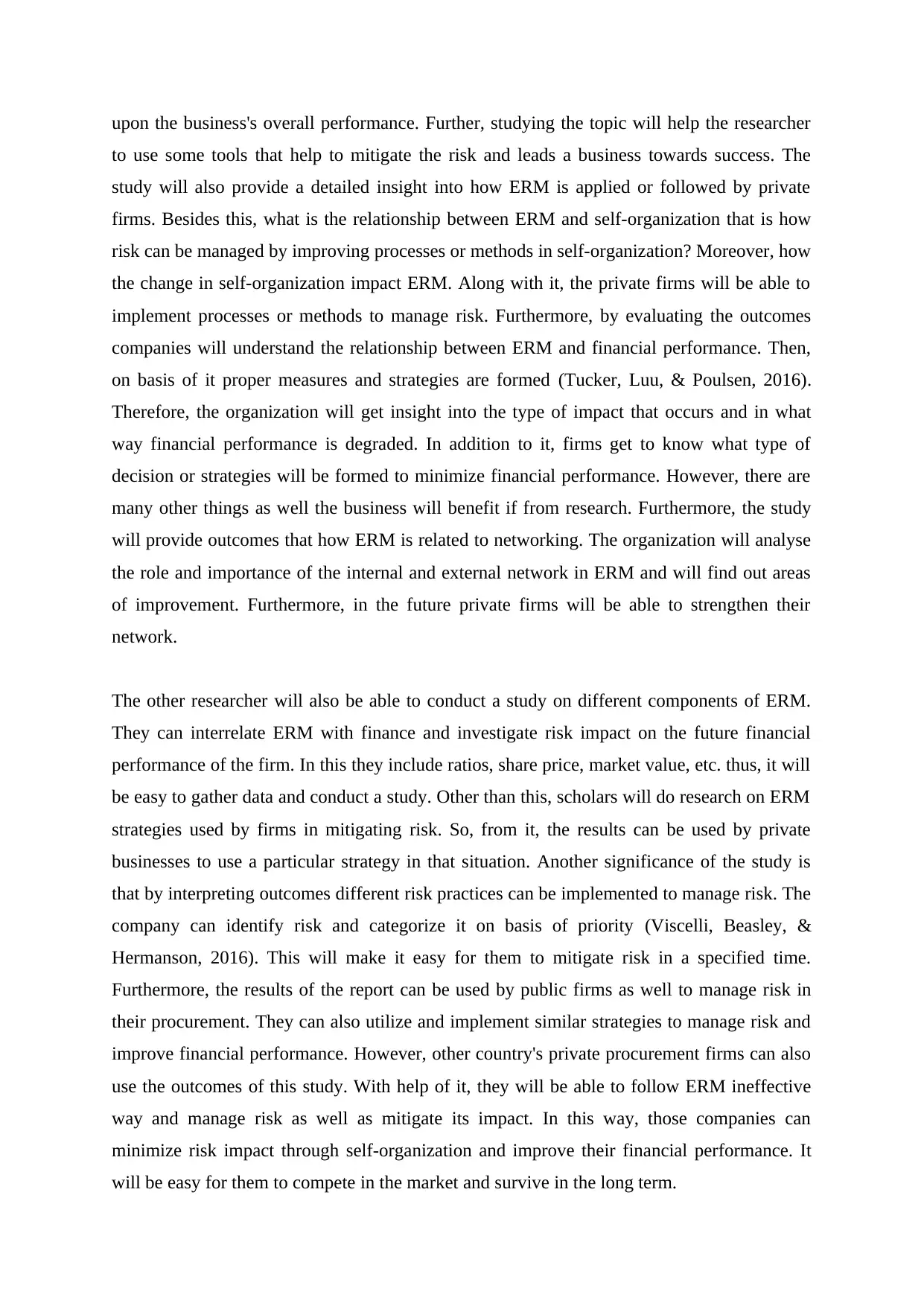
upon the business's overall performance. Further, studying the topic will help the researcher
to use some tools that help to mitigate the risk and leads a business towards success. The
study will also provide a detailed insight into how ERM is applied or followed by private
firms. Besides this, what is the relationship between ERM and self-organization that is how
risk can be managed by improving processes or methods in self-organization? Moreover, how
the change in self-organization impact ERM. Along with it, the private firms will be able to
implement processes or methods to manage risk. Furthermore, by evaluating the outcomes
companies will understand the relationship between ERM and financial performance. Then,
on basis of it proper measures and strategies are formed (Tucker, Luu, & Poulsen, 2016).
Therefore, the organization will get insight into the type of impact that occurs and in what
way financial performance is degraded. In addition to it, firms get to know what type of
decision or strategies will be formed to minimize financial performance. However, there are
many other things as well the business will benefit if from research. Furthermore, the study
will provide outcomes that how ERM is related to networking. The organization will analyse
the role and importance of the internal and external network in ERM and will find out areas
of improvement. Furthermore, in the future private firms will be able to strengthen their
network.
The other researcher will also be able to conduct a study on different components of ERM.
They can interrelate ERM with finance and investigate risk impact on the future financial
performance of the firm. In this they include ratios, share price, market value, etc. thus, it will
be easy to gather data and conduct a study. Other than this, scholars will do research on ERM
strategies used by firms in mitigating risk. So, from it, the results can be used by private
businesses to use a particular strategy in that situation. Another significance of the study is
that by interpreting outcomes different risk practices can be implemented to manage risk. The
company can identify risk and categorize it on basis of priority (Viscelli, Beasley, &
Hermanson, 2016). This will make it easy for them to mitigate risk in a specified time.
Furthermore, the results of the report can be used by public firms as well to manage risk in
their procurement. They can also utilize and implement similar strategies to manage risk and
improve financial performance. However, other country's private procurement firms can also
use the outcomes of this study. With help of it, they will be able to follow ERM ineffective
way and manage risk as well as mitigate its impact. In this way, those companies can
minimize risk impact through self-organization and improve their financial performance. It
will be easy for them to compete in the market and survive in the long term.
to use some tools that help to mitigate the risk and leads a business towards success. The
study will also provide a detailed insight into how ERM is applied or followed by private
firms. Besides this, what is the relationship between ERM and self-organization that is how
risk can be managed by improving processes or methods in self-organization? Moreover, how
the change in self-organization impact ERM. Along with it, the private firms will be able to
implement processes or methods to manage risk. Furthermore, by evaluating the outcomes
companies will understand the relationship between ERM and financial performance. Then,
on basis of it proper measures and strategies are formed (Tucker, Luu, & Poulsen, 2016).
Therefore, the organization will get insight into the type of impact that occurs and in what
way financial performance is degraded. In addition to it, firms get to know what type of
decision or strategies will be formed to minimize financial performance. However, there are
many other things as well the business will benefit if from research. Furthermore, the study
will provide outcomes that how ERM is related to networking. The organization will analyse
the role and importance of the internal and external network in ERM and will find out areas
of improvement. Furthermore, in the future private firms will be able to strengthen their
network.
The other researcher will also be able to conduct a study on different components of ERM.
They can interrelate ERM with finance and investigate risk impact on the future financial
performance of the firm. In this they include ratios, share price, market value, etc. thus, it will
be easy to gather data and conduct a study. Other than this, scholars will do research on ERM
strategies used by firms in mitigating risk. So, from it, the results can be used by private
businesses to use a particular strategy in that situation. Another significance of the study is
that by interpreting outcomes different risk practices can be implemented to manage risk. The
company can identify risk and categorize it on basis of priority (Viscelli, Beasley, &
Hermanson, 2016). This will make it easy for them to mitigate risk in a specified time.
Furthermore, the results of the report can be used by public firms as well to manage risk in
their procurement. They can also utilize and implement similar strategies to manage risk and
improve financial performance. However, other country's private procurement firms can also
use the outcomes of this study. With help of it, they will be able to follow ERM ineffective
way and manage risk as well as mitigate its impact. In this way, those companies can
minimize risk impact through self-organization and improve their financial performance. It
will be easy for them to compete in the market and survive in the long term.
⊘ This is a preview!⊘
Do you want full access?
Subscribe today to unlock all pages.

Trusted by 1+ million students worldwide
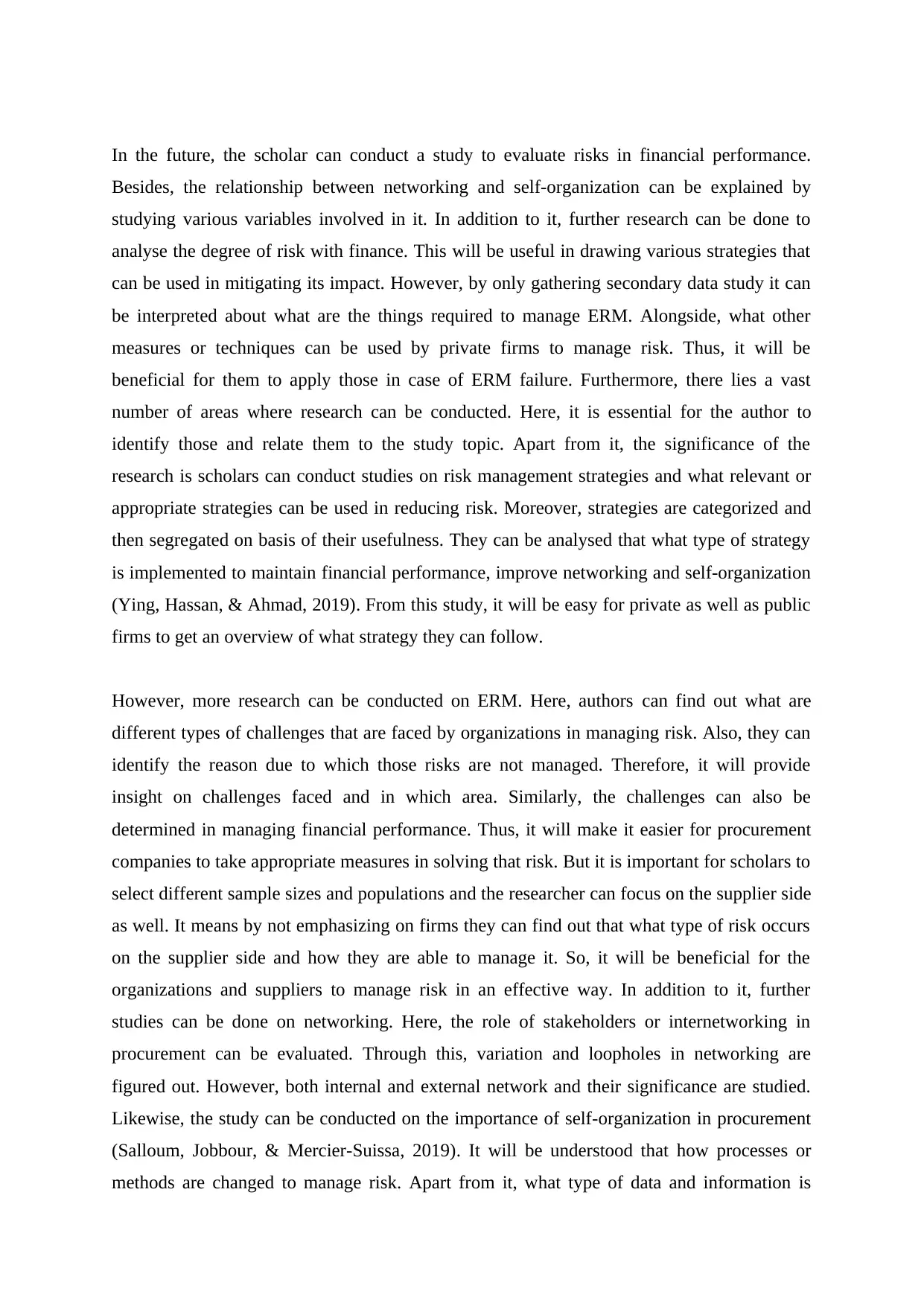
In the future, the scholar can conduct a study to evaluate risks in financial performance.
Besides, the relationship between networking and self-organization can be explained by
studying various variables involved in it. In addition to it, further research can be done to
analyse the degree of risk with finance. This will be useful in drawing various strategies that
can be used in mitigating its impact. However, by only gathering secondary data study it can
be interpreted about what are the things required to manage ERM. Alongside, what other
measures or techniques can be used by private firms to manage risk. Thus, it will be
beneficial for them to apply those in case of ERM failure. Furthermore, there lies a vast
number of areas where research can be conducted. Here, it is essential for the author to
identify those and relate them to the study topic. Apart from it, the significance of the
research is scholars can conduct studies on risk management strategies and what relevant or
appropriate strategies can be used in reducing risk. Moreover, strategies are categorized and
then segregated on basis of their usefulness. They can be analysed that what type of strategy
is implemented to maintain financial performance, improve networking and self-organization
(Ying, Hassan, & Ahmad, 2019). From this study, it will be easy for private as well as public
firms to get an overview of what strategy they can follow.
However, more research can be conducted on ERM. Here, authors can find out what are
different types of challenges that are faced by organizations in managing risk. Also, they can
identify the reason due to which those risks are not managed. Therefore, it will provide
insight on challenges faced and in which area. Similarly, the challenges can also be
determined in managing financial performance. Thus, it will make it easier for procurement
companies to take appropriate measures in solving that risk. But it is important for scholars to
select different sample sizes and populations and the researcher can focus on the supplier side
as well. It means by not emphasizing on firms they can find out that what type of risk occurs
on the supplier side and how they are able to manage it. So, it will be beneficial for the
organizations and suppliers to manage risk in an effective way. In addition to it, further
studies can be done on networking. Here, the role of stakeholders or internetworking in
procurement can be evaluated. Through this, variation and loopholes in networking are
figured out. However, both internal and external network and their significance are studied.
Likewise, the study can be conducted on the importance of self-organization in procurement
(Salloum, Jobbour, & Mercier-Suissa, 2019). It will be understood that how processes or
methods are changed to manage risk. Apart from it, what type of data and information is
Besides, the relationship between networking and self-organization can be explained by
studying various variables involved in it. In addition to it, further research can be done to
analyse the degree of risk with finance. This will be useful in drawing various strategies that
can be used in mitigating its impact. However, by only gathering secondary data study it can
be interpreted about what are the things required to manage ERM. Alongside, what other
measures or techniques can be used by private firms to manage risk. Thus, it will be
beneficial for them to apply those in case of ERM failure. Furthermore, there lies a vast
number of areas where research can be conducted. Here, it is essential for the author to
identify those and relate them to the study topic. Apart from it, the significance of the
research is scholars can conduct studies on risk management strategies and what relevant or
appropriate strategies can be used in reducing risk. Moreover, strategies are categorized and
then segregated on basis of their usefulness. They can be analysed that what type of strategy
is implemented to maintain financial performance, improve networking and self-organization
(Ying, Hassan, & Ahmad, 2019). From this study, it will be easy for private as well as public
firms to get an overview of what strategy they can follow.
However, more research can be conducted on ERM. Here, authors can find out what are
different types of challenges that are faced by organizations in managing risk. Also, they can
identify the reason due to which those risks are not managed. Therefore, it will provide
insight on challenges faced and in which area. Similarly, the challenges can also be
determined in managing financial performance. Thus, it will make it easier for procurement
companies to take appropriate measures in solving that risk. But it is important for scholars to
select different sample sizes and populations and the researcher can focus on the supplier side
as well. It means by not emphasizing on firms they can find out that what type of risk occurs
on the supplier side and how they are able to manage it. So, it will be beneficial for the
organizations and suppliers to manage risk in an effective way. In addition to it, further
studies can be done on networking. Here, the role of stakeholders or internetworking in
procurement can be evaluated. Through this, variation and loopholes in networking are
figured out. However, both internal and external network and their significance are studied.
Likewise, the study can be conducted on the importance of self-organization in procurement
(Salloum, Jobbour, & Mercier-Suissa, 2019). It will be understood that how processes or
methods are changed to manage risk. Apart from it, what type of data and information is
Paraphrase This Document
Need a fresh take? Get an instant paraphrase of this document with our AI Paraphraser
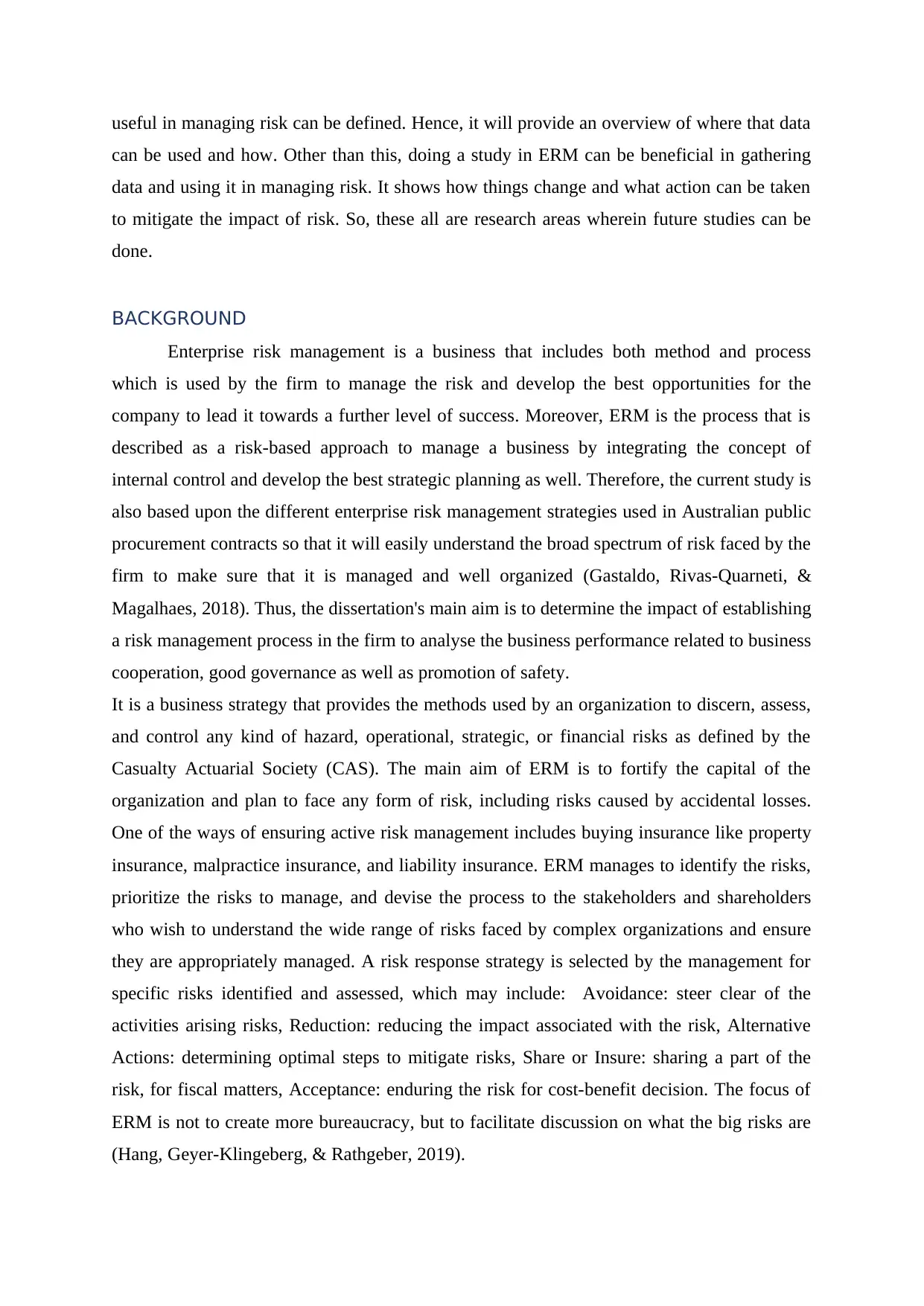
useful in managing risk can be defined. Hence, it will provide an overview of where that data
can be used and how. Other than this, doing a study in ERM can be beneficial in gathering
data and using it in managing risk. It shows how things change and what action can be taken
to mitigate the impact of risk. So, these all are research areas wherein future studies can be
done.
BACKGROUND
Enterprise risk management is a business that includes both method and process
which is used by the firm to manage the risk and develop the best opportunities for the
company to lead it towards a further level of success. Moreover, ERM is the process that is
described as a risk-based approach to manage a business by integrating the concept of
internal control and develop the best strategic planning as well. Therefore, the current study is
also based upon the different enterprise risk management strategies used in Australian public
procurement contracts so that it will easily understand the broad spectrum of risk faced by the
firm to make sure that it is managed and well organized (Gastaldo, Rivas-Quarneti, &
Magalhaes, 2018). Thus, the dissertation's main aim is to determine the impact of establishing
a risk management process in the firm to analyse the business performance related to business
cooperation, good governance as well as promotion of safety.
It is a business strategy that provides the methods used by an organization to discern, assess,
and control any kind of hazard, operational, strategic, or financial risks as defined by the
Casualty Actuarial Society (CAS). The main aim of ERM is to fortify the capital of the
organization and plan to face any form of risk, including risks caused by accidental losses.
One of the ways of ensuring active risk management includes buying insurance like property
insurance, malpractice insurance, and liability insurance. ERM manages to identify the risks,
prioritize the risks to manage, and devise the process to the stakeholders and shareholders
who wish to understand the wide range of risks faced by complex organizations and ensure
they are appropriately managed. A risk response strategy is selected by the management for
specific risks identified and assessed, which may include: Avoidance: steer clear of the
activities arising risks, Reduction: reducing the impact associated with the risk, Alternative
Actions: determining optimal steps to mitigate risks, Share or Insure: sharing a part of the
risk, for fiscal matters, Acceptance: enduring the risk for cost-benefit decision. The focus of
ERM is not to create more bureaucracy, but to facilitate discussion on what the big risks are
(Hang, Geyer-Klingeberg, & Rathgeber, 2019).
can be used and how. Other than this, doing a study in ERM can be beneficial in gathering
data and using it in managing risk. It shows how things change and what action can be taken
to mitigate the impact of risk. So, these all are research areas wherein future studies can be
done.
BACKGROUND
Enterprise risk management is a business that includes both method and process
which is used by the firm to manage the risk and develop the best opportunities for the
company to lead it towards a further level of success. Moreover, ERM is the process that is
described as a risk-based approach to manage a business by integrating the concept of
internal control and develop the best strategic planning as well. Therefore, the current study is
also based upon the different enterprise risk management strategies used in Australian public
procurement contracts so that it will easily understand the broad spectrum of risk faced by the
firm to make sure that it is managed and well organized (Gastaldo, Rivas-Quarneti, &
Magalhaes, 2018). Thus, the dissertation's main aim is to determine the impact of establishing
a risk management process in the firm to analyse the business performance related to business
cooperation, good governance as well as promotion of safety.
It is a business strategy that provides the methods used by an organization to discern, assess,
and control any kind of hazard, operational, strategic, or financial risks as defined by the
Casualty Actuarial Society (CAS). The main aim of ERM is to fortify the capital of the
organization and plan to face any form of risk, including risks caused by accidental losses.
One of the ways of ensuring active risk management includes buying insurance like property
insurance, malpractice insurance, and liability insurance. ERM manages to identify the risks,
prioritize the risks to manage, and devise the process to the stakeholders and shareholders
who wish to understand the wide range of risks faced by complex organizations and ensure
they are appropriately managed. A risk response strategy is selected by the management for
specific risks identified and assessed, which may include: Avoidance: steer clear of the
activities arising risks, Reduction: reducing the impact associated with the risk, Alternative
Actions: determining optimal steps to mitigate risks, Share or Insure: sharing a part of the
risk, for fiscal matters, Acceptance: enduring the risk for cost-benefit decision. The focus of
ERM is not to create more bureaucracy, but to facilitate discussion on what the big risks are
(Hang, Geyer-Klingeberg, & Rathgeber, 2019).
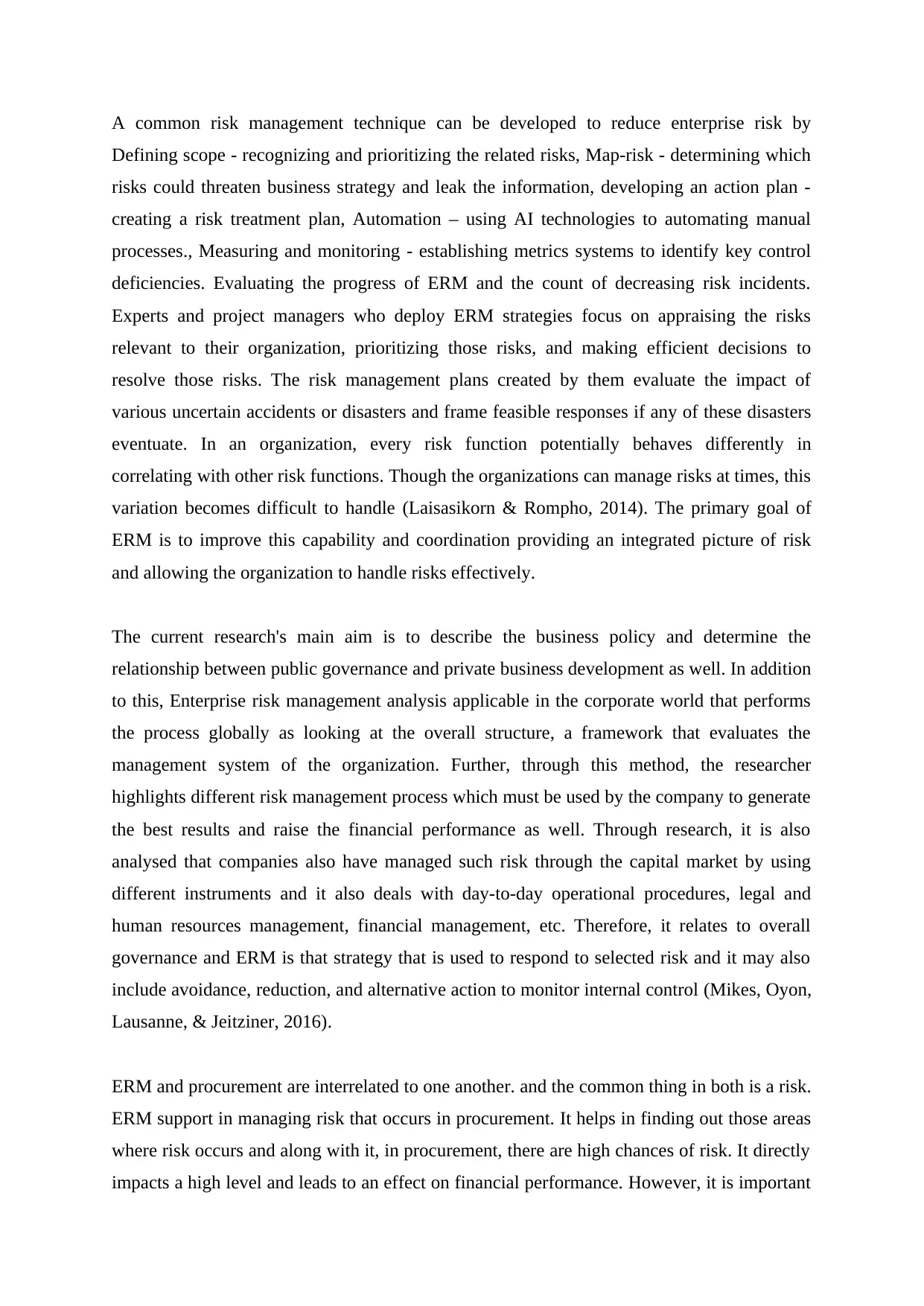
A common risk management technique can be developed to reduce enterprise risk by
Defining scope - recognizing and prioritizing the related risks, Map-risk - determining which
risks could threaten business strategy and leak the information, developing an action plan -
creating a risk treatment plan, Automation – using AI technologies to automating manual
processes., Measuring and monitoring - establishing metrics systems to identify key control
deficiencies. Evaluating the progress of ERM and the count of decreasing risk incidents.
Experts and project managers who deploy ERM strategies focus on appraising the risks
relevant to their organization, prioritizing those risks, and making efficient decisions to
resolve those risks. The risk management plans created by them evaluate the impact of
various uncertain accidents or disasters and frame feasible responses if any of these disasters
eventuate. In an organization, every risk function potentially behaves differently in
correlating with other risk functions. Though the organizations can manage risks at times, this
variation becomes difficult to handle (Laisasikorn & Rompho, 2014). The primary goal of
ERM is to improve this capability and coordination providing an integrated picture of risk
and allowing the organization to handle risks effectively.
The current research's main aim is to describe the business policy and determine the
relationship between public governance and private business development as well. In addition
to this, Enterprise risk management analysis applicable in the corporate world that performs
the process globally as looking at the overall structure, a framework that evaluates the
management system of the organization. Further, through this method, the researcher
highlights different risk management process which must be used by the company to generate
the best results and raise the financial performance as well. Through research, it is also
analysed that companies also have managed such risk through the capital market by using
different instruments and it also deals with day-to-day operational procedures, legal and
human resources management, financial management, etc. Therefore, it relates to overall
governance and ERM is that strategy that is used to respond to selected risk and it may also
include avoidance, reduction, and alternative action to monitor internal control (Mikes, Oyon,
Lausanne, & Jeitziner, 2016).
ERM and procurement are interrelated to one another. and the common thing in both is a risk.
ERM support in managing risk that occurs in procurement. It helps in finding out those areas
where risk occurs and along with it, in procurement, there are high chances of risk. It directly
impacts a high level and leads to an effect on financial performance. However, it is important
Defining scope - recognizing and prioritizing the related risks, Map-risk - determining which
risks could threaten business strategy and leak the information, developing an action plan -
creating a risk treatment plan, Automation – using AI technologies to automating manual
processes., Measuring and monitoring - establishing metrics systems to identify key control
deficiencies. Evaluating the progress of ERM and the count of decreasing risk incidents.
Experts and project managers who deploy ERM strategies focus on appraising the risks
relevant to their organization, prioritizing those risks, and making efficient decisions to
resolve those risks. The risk management plans created by them evaluate the impact of
various uncertain accidents or disasters and frame feasible responses if any of these disasters
eventuate. In an organization, every risk function potentially behaves differently in
correlating with other risk functions. Though the organizations can manage risks at times, this
variation becomes difficult to handle (Laisasikorn & Rompho, 2014). The primary goal of
ERM is to improve this capability and coordination providing an integrated picture of risk
and allowing the organization to handle risks effectively.
The current research's main aim is to describe the business policy and determine the
relationship between public governance and private business development as well. In addition
to this, Enterprise risk management analysis applicable in the corporate world that performs
the process globally as looking at the overall structure, a framework that evaluates the
management system of the organization. Further, through this method, the researcher
highlights different risk management process which must be used by the company to generate
the best results and raise the financial performance as well. Through research, it is also
analysed that companies also have managed such risk through the capital market by using
different instruments and it also deals with day-to-day operational procedures, legal and
human resources management, financial management, etc. Therefore, it relates to overall
governance and ERM is that strategy that is used to respond to selected risk and it may also
include avoidance, reduction, and alternative action to monitor internal control (Mikes, Oyon,
Lausanne, & Jeitziner, 2016).
ERM and procurement are interrelated to one another. and the common thing in both is a risk.
ERM support in managing risk that occurs in procurement. It helps in finding out those areas
where risk occurs and along with it, in procurement, there are high chances of risk. It directly
impacts a high level and leads to an effect on financial performance. However, it is important
⊘ This is a preview!⊘
Do you want full access?
Subscribe today to unlock all pages.

Trusted by 1+ million students worldwide
1 out of 49
Related Documents
Your All-in-One AI-Powered Toolkit for Academic Success.
+13062052269
info@desklib.com
Available 24*7 on WhatsApp / Email
![[object Object]](/_next/static/media/star-bottom.7253800d.svg)
Unlock your academic potential
Copyright © 2020–2025 A2Z Services. All Rights Reserved. Developed and managed by ZUCOL.





